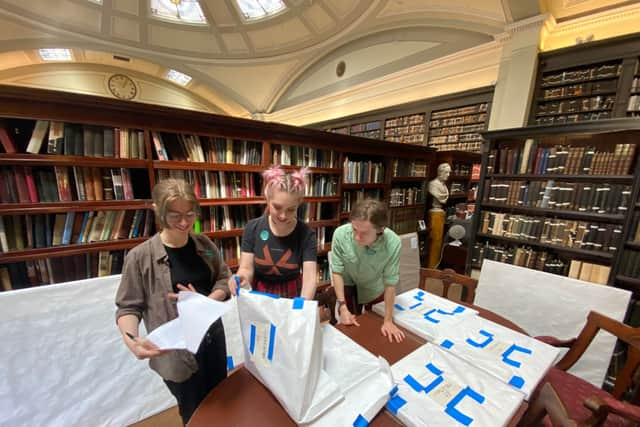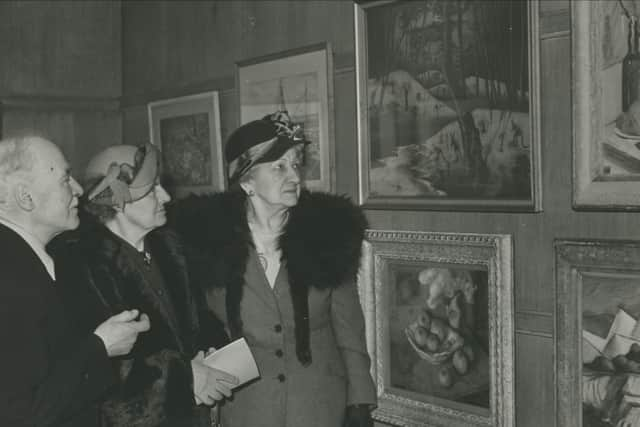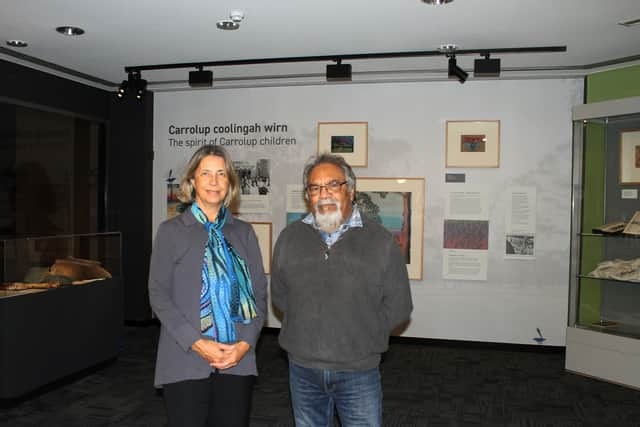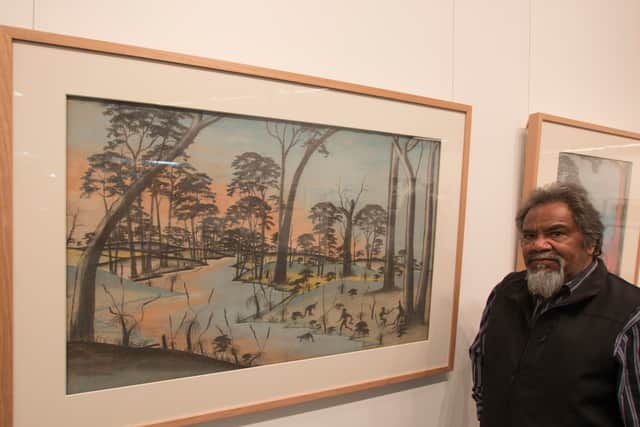Search for artworks by Australian First Nation children as drawings go on display in Manchester
and live on Freeview channel 276
A new exhibition in Manchester of artworks created by Australian First Nation children who were kidnapped from their families is shining a light on a dark chapter of history.
Tracing the art of a Stolen Generation: the child artists of Carrolup will be on show at the The Portico Library in the city until late September.
Advertisement
Hide AdAdvertisement
Hide AdThe drawings depicting Australia’s landscapes and wildlife are all the more heartbreaking due to the appalling circumstances in which they were created at the Carrolup school in remote Western Australia.
Organisers have also been sharing the remarkable story of how the art became known in the UK in the 20th century - and they are wondering if any paintings done by Aboriginal youngsters might still be around in Greater Manchester.
The Portico Library has spoken of its pride at hosting such an important art exhibition and how it ties in with its own work to inform Mancunians about Australian First Nations people.
What is the exhibition in Manchester and when is it on?
A selection of the hundreds of artworks created by First Nation children at the remote settlement of Carrolup is being displayed at The Portico Library on Mosley Street in Manchester from 7 July until 26 September.
Advertisement
Hide AdAdvertisement
Hide AdAboriginal children were kidnapped from their families and taken, often vast distances, to places like Carrolup which were called native settlements.. There they were incarcerated far from the nearest town.


This grim chapter of colonial history involving the children who became known as the Stolen Generations became better known internationally thanks to the film Rabbit-Proof Fence, which starred Kenneth Branagh and was based on a book by Australian author Doris Pilkington Garimara telling a story of two girls who escaped from one of the settlements to return to their families.
The artworks at Carrolup were created when new teachers Noel and Lily White arrived at the settlement’s school and Mr White encouraged the youngsters to take walks outside, come back and draw what they had seen.
Many of the drawings depict the landscape and wildlife of Australia.
How did the Carrolup works become known in the UK?
Advertisement
Hide AdAdvertisement
Hide AdRemarkably this is not the first time drawings from Carrolup have been shown in the UK, as the art captured the attention of a philanthropist called Florence Rutter.
Having travelled to Australia to set up Soroptimist clubs, she met the artists and arranged exhibitions of their work, first taking them with her across Australia and New Zealand and then bringing them over to the UK.
They were shown in towns and cities across Britain, including in Rochdale in October and November 1950 and at the Manchester Cotton Board.


Some of the artworks were also sold, with proceeds going to buying more art materials to be sent back to Carrolup.
Advertisement
Hide AdAdvertisement
Hide AdAfter that the works lay undiscovered and forgotten for four decades at a university in North America before they made their way into The Herbert Mayer Collection of Carrolup Children’s Art, which is now in the care of the John Curtin Gallery at Curtin University in Perth and jointly looked after in a partnership with Indigenous elders.
It is work from this collection that is now back on UK shores.
A request to the Greater Manchester public from the exhibition’s organisers
As it is known that many of the works Florence Rutter exhibited were sold and they were displayed in Greater Manchester organisers of the new exhibition at The Portico are wondering if any more Carrolup art may still be around in the city-region.
They say it is important for the descendants of the artists to be able to continue trying to heal from their traumatic history for art done by First Nation children to be found and documented.
Advertisement
Hide AdAdvertisement
Hide AdThe university has set up the Carrolup Centre for Truth-telling, an ambitious project to create a permanent home for the art in Australia and provide an opportunity for others to learn about this tragic period in the country’s history.
John Curtin Gallery director Chris Malcolm said: “We are encouraging people to help our global search for these culturally-significant drawings by checking their attics, cupboards and households for any similar artworks.
“The key clues that people need to be looking out for include the use of chalk on paper and many depict the Australian landscape and wildlife, including kangaroos. We would urge everyone to see for themselves at the new exhibition in Manchester and Glasgow which tell this incredible story.


“A critical part of the reconciliation process for addressing the wrongs of the past include uncovering these priceless artworks as they could be the only physical connection a family has with their ancestors. The artworks form a basis from which we can deepen our knowledge and understanding of our past, and help us walk together towards a better future.”
Advertisement
Hide AdAdvertisement
Hide AdDr Helen Idle, adjunct curator from Curtin University, said: “We’d like people to have a think about whether their grandparents ever mentioned someting like this or whether family members might have seen these exhibitions Florence Rutter put on.
“We don’t know how much the artworks were sold for. Maybe people bought them as a charitable act because the money was going back to Australia to support Aboriginal children being kept away from their families.”
Raising awareness of a complex and sensitive part of history
The stunning drawings are all the more poignant and heartbreaking when the terrible situation in which they were created is considered, and the exhibition forms part of ongoing efforts to inform and educate people about Australia’s dark colonial history.
The exhibition and Curtin University’s work with the Carrolup art is being guided by Goreng Elder of the Nyungar Nation Ezzard Flowers and curated by Michelle Broun, an Australian First Nations art curator.
Advertisement
Hide AdAdvertisement
Hide AdDr Idle spoke about what it means to confront the truth of what happened to the First Nations people in Australia.
She said: “People are looking at their history and telling stories from everybody’s point of view, not just those who controlled the law and the pen.


“Aboriginal people have always known these stories and these pictures give us access to them in a different way. They are incredibly beautiful and heartwarming to look at and the manager of the centre for truth telling says that despite the tragic circumstances these children were living in the artworks show their joy and spirit.
“Their descendants and non-Indigenous people can feel that resilience and hope for the future.
Advertisement
Hide AdAdvertisement
Hide Ad“This history is complicated, layered and rich. It’s difficult but all history is difficult. It’s just the truth of it. When he looked over what we had done for the exhibition Ezzard Flowers asked us to mention the fact that by law Aboriginal people were not permitted to move anywhere or do anything. Everything in their daily lives was controlled.”
A history that is not as unfamiliar as we might think
The curators of the exhibition say one reason they are particularly keen for people in the UK to see the artworks is that the story of what happened to First Nations children is not as remote from British history as might be expected.
Dr Idle says that hundreds of thousands of British children were taken from their home country and transported to Canada and Australia.
One community in Western Australia, not far from Carrolup where the First Nations children were being held, received 3,500 children until 1983. Those who were treated in this way received an apology from Gordon Brown when he was prime minister.
Advertisement
Hide AdAdvertisement
Hide AdDr Idle said: “The children may have been orphans, or they may not have been. They were held in institutions, told to pack their bags and told they were going on a day out.
“They ended up in a ship going to Australia. It’s estimated about 150,000 children were taken across the water from Britain to the Commonwealth dominions.
“This was in a similar period to the First Nations children and it seems there was a trend in the way governments were controlling their populations at the time.”
What has The Portico Library said?
Dr Thom Keep, librarian at The Portico Library, said: “It’s a huge honour to host the artworks from the child artists of Carrolup at the Portico. For the last six years, the library has sort to elevate and reveal stories from First Nations people in Australia that are frequently overlooked, dismissed and misrepresented in British books about Australia.
Advertisement
Hide AdAdvertisement
Hide Ad“This is notably the case in the Portico’s 19th century travel collection, which includes narratives from British journeys to and within Australia such as those by James Cook and Mathew Flinders.
“This exhibition extends our responsibility to platform overwritten unheard voices with what is, paradoxically, a deeply tragic and uplifting story.
“We are also committed to supporting the Noongar people in their quest to find artworks made by their ancestors as children and shown in Manchester and Rochdale in 1950s.”
Comment Guidelines
National World encourages reader discussion on our stories. User feedback, insights and back-and-forth exchanges add a rich layer of context to reporting. Please review our Community Guidelines before commenting.
